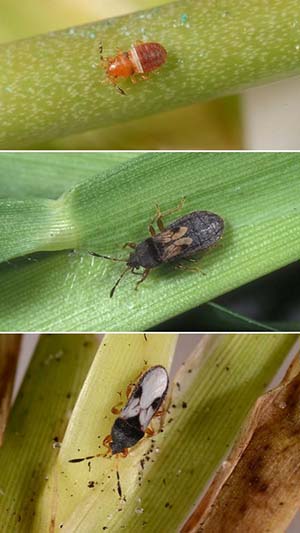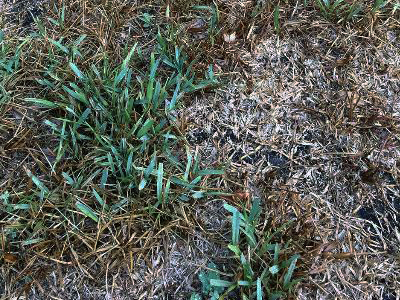Chinch Bugs

Some stages of the chinch bug lifecycle: nymph (top), short-winged adult (middle), and adult (bottom). Photo: Lyle Buss, UF/IFAS Department of Entomology and Nematology
St. Augustinegrass is the most widely planted turfgrass species in Florida lawns, estimated to cover more than two million acres. Also superlative in Florida is the southern chinch bug. This insect is the most damaging insect pest of turfgrass in the state. They are a major pest of St. Augustinegrass and attack zoysiagrass, too.
Catching a southern chinch bug infestation early is the key to saving your turf. Below are some tips for identifying and managing this pest.
Identification
It's tempting to treat before identifying a pest, but proper insect ID is essential to choosing the best treatment. Insects go through stages of metamorphosis and look different in the egg, nymph, and adult stages. To identify them, you need to know what a chinch bug looks like at each stage of growth.
There are also insects in the turf that are working with you, not against you. We call these beneficial insects. Big-eyed bugs could be easily confused with a chinch bug, except "big-eyes" eat chinch bugs for breakfast! Being able to tell the beneficials from the pests will save you lots of time and energy.
Chinch bugs are very small insects that live in your turf. They feed by draining the sap from grass until it withers. Chinch bugs like to hide in between the sheaths of the leaf blades and in the thatch layer in the turf. Young chinch bugs are orange with a white stripe across their back. As they grow older, they emerge as black, winged adults. The final stage of the lifecycle is an adult with black and white wings and orange legs. Even at this stage they are only a fifth of an inch long, about the length of a grain of rice. At this size they can be hard to spot.
Areas damaged by chinch bugs appear as yellow to brown patches. The center of these affected areas may even be dead and bare. Injury typically occurs first in grass that's water-stressed or in full sun. Chinch bugs are most active when it is warm, but may cause damage year-round, particularly in South Florida.
It is important to remember that not all brown grass indicates a chinch bug infestation. If you suspect you have chinch bugs, inspect the border between the brown and green grass for the tiny, black-and-white adults or orange nymphs.
Avoiding Infestation

St. Augustinegrass heavily infested with southern chinch bug will initially turn yellow but rapidly progress to dark brown. The grass will die if the pest is not controlled.
Photo: Adam Dale, UF/IFAS Department of Entomology and Nematology
Chinch bug infestations can appear at any time, but are most common in turf that has been stressed. Turf stress is simple to control by using best management practices. In general, avoid:
- Poor irrigation distribution
- Mowing too short
- Too much nitrogen in the fertilizer
Even the best practices can still result in some pest issues. Regular scouting can help you identify a problem early and select the best treatment.
- Monitor your landscape for potential pest issues. Chinch bugs live in groups, and their damage is characterized by an irregular pattern spreading outwards.
- Suspect chinch bugs? Get a handheld vacuum and vacuum about 1 square foot of grass in an area that includes both dead and living grass. This is likely a zone of active feeding.
- Dump debris from the vacuum on to white paper or a light-colored tray and look for chinch bugs. For help identifying your findings, contact your county Extension office.
Thatch management is also important. Thatch is organic matter that doesn't regularly decompose and can build up beneath the turf. This is a perfect habitat for chinch bugs. If you circle back to proper irrigation, mowing height, and proper fertilization, thatch should not be a major issue.
Pest Management
Chinch bugs are a major pest of a major crop. Unfortunately, they are becoming resistant to many of the insecticides in our pesticide cabinet. This makes cultural and biological control methods all the more crucial. Always incorporate non-chemical options like reducing thatch and minimizing fertilizer use. Encouraging beneficial insects will also help you manage the pest problem.
If you do find chinch bugs and the infestation begins to cause damage, treat only with an appropriate pesticide. If you encounter the same pest again and again, rotate the chemical controls you choose each season. This strategy is called "rotating modes of action." You can learn more about choosing the best chemical control in Managing Southern Chinch Bug in Warm Season Turfgrasses.
For help managing or avoiding chinch bugs, contact your county Extension office.
Our thanks to Hannah Wooten, UF/IFAS Commercial Horticulture Extension Agent for Orange County, for the contents of this article.
Also on Gardening Solutions
More from UF/IFAS
- Ask IFAS: Chinch Bugs
- Chinch Bug Monitoring--UF/IFAS Extension Orange County
- Chinch Bugs in Florida Lawns--UF/IFAS Extension Sarasota County
- Featured Creatures: Chinch Bugs
- Managing Southern Chinch Bug in Warm Season Turfgrasses
- Southern Chinch Bug, Blissus insularis Barber (Insecta: Hemiptera: Blissidae)

